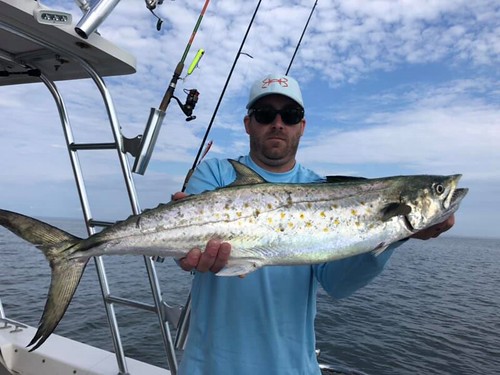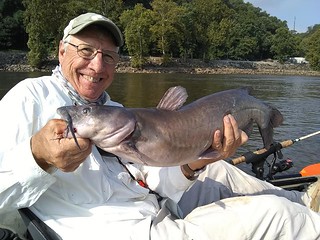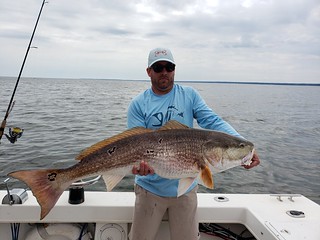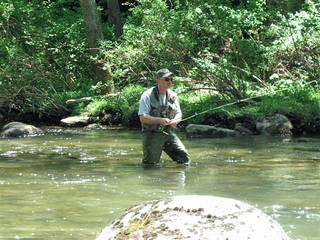
Photo by Captain “walleye” Pete Dahlberg
September is an exciting month for those who love the outdoors and fishing is usually at the top of the list. Mild late summer weather is providing exciting fishing opportunities across the Maryland landscape from the western mountains to the Atlantic Ocean. In the Chesapeake Bay, we have relatively warm water, higher salinities, and a very strong run of Spanish mackerel which is delighting those who are able to get out and fish for them.
Forecast Summary: Sept. 11 – Sept. 17
The upcoming week will bring more warm, sunny and calm weather that will halt the slow decline in Bay water temperatures seen recently. In some of the shallower rivers, water temperatures will slightly increase. Overall Bay conditions should remain rather stable this week with gamefish holding at similar locations and depths. As always, during the day, focus on the deeper, cooler waters that still have adequate oxygen for Bay gamefish. As surface waters cool overnight, check nearby shoal areas at first light for larger striped bass hunting for breakfast.
Bay surface salinities are still below normal for this time of year but continue to increase from last month. Current oxygen conditions — found at our “Don’t Fish Below This Depth” page — are as follows: from the Virginia state line north to Point no Point, 45 feet; Point No Point up to Little Choptank, 32 feet; Little Choptank to Choptank River, 25 feet; Bloody Point, 16 feet; Bay Bridge, 23 feet; Swan Point, 17 feet; Still Pond, 23 feet; and from there north to the Flats, adequate oxygen is found from top to bottom. For oxygen forecasts, see VIMS Depth to 3 mg/l .
Expect reduced water clarity from algal blooms on the mainstem of the Bay from the Patapsco River across to the Chester River, south to Bloody Point, and then hugging the western shore to below the mouth of the Patuxent River. Blooms are also present on the Back and Northeast rivers. On the Potomac River, patchy algal blooms are present on the Wicomico as well as from Colonial Beach to the mouth of the river.
Bay water temperatures throughout the Bay have dropped a few degrees from last week down to 77 degrees. Water temperatures at Little Falls have dropped to about 80 degrees. Expect normal flows from most Maryland’s rivers and streams this week. There will be above average tidal currents all week as a result of the upcoming full moon Sept. 14.
For the full weekly fishing conditions summary and more detailed and up-to-date fishing conditions in your area of the bay, be sure to check out Click Before You Cast. You can now get regular updates on Maryland’s waters and the creatures that call them home sent to your inbox with our new Eyes on the Bay newsletter. Sign up online.
Upper Chesapeake Bay

Tim Campbell is all smiles with this blue catfish. Photo courtesy of Tim Campbell
Fishing for striped bass in the areas near the Susquehanna Flats up to the Conowingo Dam pool has improved. The best time to fish continues to be at dawn, and although most of the striped bass being caught are sub-legal there is plenty of action. Topwater lures and soft plastic jigs tend to be the two most popular ways to fish. The Conowingo Dam is in a daytime power generation mode this week.
Large flathead catfish have been providing some exciting fishing in the dam pool and reservoir. Several in the 35-pound range have been caught recently and smaller ones are common above and below the dam. Fresh cut bait or live white perch or bluegills make great baits. Channel catfish are very common in the lower Susquehanna River and most of the tidal rivers in the upper bay region. Blue catfish are becoming more common in the area and many are growing to some rather large sizes.
White perch are a popular target in the many creeks and tidal rivers of the upper bay region. Some slightly cooler water temperatures last week were causing them to be found more frequently in the shallower areas near shoreline structure, but warming water temperatures this week may cause some changes in their behavior and location. Casting small spinnerbaits, spinners, or soft plastic jigs is a fun way to catch them on light tackle. Fishing in deeper waters near structure with bottom rigs baited with pieces of bloodworms or grass shrimp can put some white perch in the ice chest also.
Striped bass tend to be spread out throughout the upper bay region so it may take a bit of exploring to find them. As most know they have been stuck at several locations in less than 15 feet of water for several months. We are seeing some better oxygen mixing of surface and deeper waters, which would be further aided by cooler and windier weather in late September and early October. Some locations to check out are the Pooles Island Lumps, Gales Lumps, Hodges Bar, Swan Point and the Triple Buoys, Love Point and Podickory Point have lost some of their luster recently as fish-producing locations but certainly worth a look. There has been a little action at the east side of the Bay Bridge up close to the piers, but nothing like it was last month.
Live-lining spot continues to be one of the most popular ways to fish and jigging can be productive when suspended fish can be found. Anglers are reminded that circle hooks are required when live-lining or chumming in tidal waters. Any sub-legal fish should be released as quickly as possible, with minimal handling. When jigging, 6-inch to 8-inch soft plastics in white, pearl or chartreuse combinations are working well on ½-ounce skirted jig heads. Trolling is becoming a better option along channel and shoal edges. Bucktails dressed with soft plastics pulled in tandem or small spoons and red hoses behind inline weights are working well. All of these lures can also be pulled behind umbrella or coat hanger rigs as trailers and are working well.
Middle Bay
It appears that Thomas Point is the most popular place to live-line or jig for striped bass this week. A large fleet has been positioned around the outside edge of Thomas Point and to a lesser degree Tolly Bar. Most of the striped bass being caught are sub-legal in size but some nice-sized ones are part of the mix. Spot are still readily available in the shallower areas, so this method of fishing will remain popular. Anglers are reminded that circle hooks are required for live-lining and chumming.

Photo by Mark Crowe
Spanish mackerel are spread throughout the region along main channel edges of the Bay. Trolling small spoons behind No. 1 planers and inline weights at a fast clip is one of the best ways to target them. Watching for diving seagulls and breaking fish is a fun and exciting way to also catch them. A mix of small striped bass and bluefish are feeding on bay anchovies and Spanish mackerel are joining in the melee. Casting heavy metal jigs and letting them settle down into the action for about 5 seconds and then speed reeling is a great way to catch the Spanish mackerel and avoid the striped bass and bluefish.
Those wishing to troll for bluefish and striped bass are doing so with a mix of bucktails, spoons and red hoses, behind inline weights along channel edges or using spoons or bucktails as trailers behind umbrella rigs or spreader bars that are often called clothes hanger rigs. The Poplar Island area has been a good place to troll. A few cobia have been caught recently so make sure to have a couple of red hoses in your trolling spread.
More than a few large red drum are being caught by jigging with heavy spoons or large soft plastics — when and where the fish can be spotted on depth finders. Often they can be spotted in the vicinity of breaking fish lurking close to the bottom. They tend to show up as very heavy marks on depth finders due to their large air bladders. If you tangle into one, make sure your crewmates are ready to carefully help land it, take a quick picture and return them to the Bay.
White perch fishing has been good and when water temperatures cool, the shallow water fishery will last later into the morning and starting earlier in the evenings. Shoreline structure made up of rip rap, old piers, fallen treetops, and prominent points are great places to target. Small spinnerbaits, spinners, and even small crankbaits are good lures to use with light tackle. Fishing deeper waters over live oyster bottom with bottom rigs and pieces of bloodworms or grass shrimp is another way to catch them.
Lower Bay
The marvelous fishing for Spanish mackerel is taking center stage. They are being caught by trolling and casting throughout the region. Those trolling are working the steeper channel edges where bay anchovies are being swept along by swift currents. They are using a mix of small spoons behind inline weights and small planers and trolling with speeds close to ten knots with good results.
Breaking fish and diving seagulls are being spotted in the region. This is where small striped bass and bluefish are chasing Bay anchovies and the Spanish mackerel are zipping through and snapping up the anchovies. An effective method of catching them is casting small heavy spoons, metal jigs or small jigs and allowing them to settle to lower depths and then speed reeling to avoid the small striped bass and bluefish and attract the attention of the Spanish mackerel.

Photo by Wayne Young
Cobia continue to be found and are being caught by trolling red hoses or by chumming and baiting the fish with live eels when they come close to the boat. Those with a flying bridge can spot them swimming close to the surface and cast live eels or large soft plastics to them. Most of the cobia being seen are sub-legal in size; 40 inches is the minimum length.
Large red drum can be found most anywhere in the main part of the Bay, but the area between the Middle Grounds and the Target Ship has been the best place to find them. Sometimes they can be spotted by surface slicks or on depth finders. Jigging with large heavy spoons or soft plastic jigs is a fun way to enjoy some great catch and release action. They can also be caught by trolling large spoons behind inline weights and close to the bottom.
Striped bass are spread out in the lower Potomac River down to Point Lookout and Cornfield Harbor. Live-lining is the most popular way to catch them. Small sub-legal striped bass tend to dominate the fishery and they are being caught as far north as the Wilson Bridge.
Bottom fishing for a mix of small croaker and spot remains good near the mouth of the Patuxent and Potomac rivers. Large spot have been hard to find but white perch have been helping to fill coolers. Channel and blue catfish also add a hefty addition to any days catch.
On the eastern side of the bay along the lower Eastern Shore creeks and marsh edges, speckled trout are a favorite target. Casting white or pink Gulp mullet baits are popular lures to use; topwater lures are a good choice when fishing stump fields. Fishing the creeks on a falling tide with pieces of soft crab is another good way to catch them. Flounder fishing is reported to be fair to good along channel edges in Pocomoke Sound, most tend to be undersized. Bottom fishing for a mix of small spot and croaker is good, white perch fishing is excellent in the tidal creeks, rivers and sounds.
Recreational crabbing is good to excellent this week in the middle and lower Bay tidal creeks and rivers. It is reported to be fair in the upper bay region. Some of the best crabbing is reported to be in the shallower waters near hard bottom and grass. Recreational crabbers will see a lot of sooks chewing up baits but there is the reward of some large jimmies in the mix.
Freshwater Fishing
Fishing in the western region continues to provide plenty of fun fishing opportunities. At Deep Creek Lake, most of the vacationing crowds are gone and the lake is settling down to a more placid scene. Drifting along deep grass edges and fishing with minnows is a great way to catch a mix of smallmouth bass, large yellow perch, chain pickerel, and largemouth bass. The largemouth bass are still in a summer mode of behavior, but those nighttime feeding sprees are beginning to last later into the morning hours and start earlier in the evening. Targeting the coves and grass during those times and shade such as floating docks and fallen treetops during the day is a good strategy.
The catch-and-release, trophy, and fly-fishing trout management waters are offering fun and exciting fishing, and the Savage River is an example. Native brook trout, wild brown trout, and rainbow trout inhabit the river, and there are two trophy trout fishing areas in place. The upper half of the river is fly fishing only, while the lower half to the Potomac is open to spinning or fly fishing tackle using single hook artificial lures or flies. Regulations include a two trout per day creel limit with an 18-inch minimum size for brown trout and 12-inch minimum size for brook trout, while there is no size restriction for rainbow trout. Recent surveys showed an average adult trout species density at 827 trout per mile in the upper section of the river and 924 adult trout per mile in the lower section of the river. Reproduction for both brook trout and brown trout showed an average of 704 fingerling sized trout per mile.

Photo courtesy of John Mullican
Water temperatures in the lakes, ponds, and tidal rivers of Maryland are beginning to cool ever so slightly due to cool night time temperatures. Largemouth bass are generally still sticking to a summer mode of feeding behavior where they come in shallow towards dark, feed all night in the shallows and retreat to deeper waters or shade during the day. They are beginning to linger in the shallows later into the morning hours and moving into feeding areas earlier in the evenings.
Targeting grass with a variety of topwater lures or soft plastics is a good tactic early in the morning and late evenings. Working shade such as brush, fallen treetops, sunken wood, bridge piers and underneath docks with soft plastics, crankbaits and grubs often works well. Dropping weighted soft plastics or stick worms through grass mats in slightly deeper waters can work well also.
Fishing for northern snakeheads is good right now in the upper reaches of the creeks that into the tidal Potomac and Patuxent rivers. The lower Dorchester County tidal rivers and creeks are also an excellent place to fish for them. Buzzbaits, chatterbaits and frogs tend to be the best baits to use when fishing grass.
Crappie are beginning to school up near sunken wood, bridge piers, marina docks and most any kind of deep sunken structure. Minnows or small jigs under a slip bobber is a great way to target them. The tidal Potomac near the Wilson Bridge, the Deer Park-Nicodemus Road bridge across Liberty Reservoir, Piney Run Reservoir, Unicorn Lake, and Wye Mills Lake are just a few of the good places to fish for crappie in Maryland. Explore other freshwater fishing hot spots on our website.
Atlantic Ocean and Coastal Bays

Photo courtesy of Rich Watts
Kingfish continue to provide plenty of fun for those fishing in the surf with pieces of bloodworms on bottom rigs. Spot, croaker and blowfish have also been part of the mix. Small bluefish are being caught on cut spot or mullet and a few enterprising anglers have been putting out a rig with sand fleas and catching a black drum or pompano now and then.
At the inlet and Route 50 Bridge area, bluefish are moving in and out of the inlet on the tides. Casting Got-Cha lures, bucktails or metal is a good way to catch them; drifting cut bait can also work well. Flounder are present in the area and a proven tactic for catching the larger ones casting white Gulp baits and bouncing them close to the bottom. Flounder fishing has also been good in the back bay channel areas. The throwback ratio can be high when fishing minnows or squid but larger baits such as live spot or Gulp baits often produce larger flounder.
Outside the inlet and close to shore, a mix of Spanish and king mackerel are being found near the shoal areas along with bluefish. Trolling silver spoons behind inline weights is the best way to catch them. Cobia are still in the area and are being caught by trolling red hoses or sight fishing and casting live eels.
Sea bass fishing is improving and many anglers are experiencing double-digit catches of sea bass and adding a few flounder to the mix. False albacore and a few chicken dolphin are being found around the 30 Fathom lumps.
Farther offshore at the canyons there is some exciting action. The Baltimore, Wilmington and Norfolk canyons have been producing a wide variety of fish. White marlin catches have been good, some large yellowfin tuna and wahoo are being caught, and boats are loading up on chicken dolphin.
“The world is wide and there must be innumerable wild beautiful places yet unexplored that await the hunter and fisherman. Of these I am always dreaming and creating mental pictures. Yet the waters a fisherman learns to love always call him back.” — Zane Grey
Maryland Fishing Report is written and compiled by Keith Lockwood, Maryland Department of Natural Resources fisheries biologist.
Click Before You Cast is written by Tidewater Ecosystem Assessment Director Tom Parham.
This report is now available on your Amazon Echo device — just ask Alexa to “open Maryland Fishing Report.”
